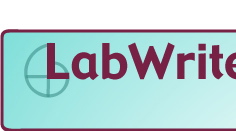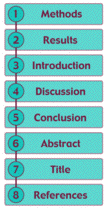SECTION THREE : Introduction
Establishing a context for the lab
Step 1: Revise your answer to PreLab
question 1 in one or two paragraphs. Begin the Introduction with 1 or
2 sentences clearly stating what scientific concept the lab is about.
Then use the rest of your answer to question 1 to complete the paragraph
with information about the scientific concept. Revise your answer so that
it includes only the information that relates specifically to this lab.
If you have a lot of information, make two paragraphs. Note any citations
you use here for including in the References section of your report.
More Help:
- If you are having trouble writing a good opening sentence for the
lab report, you can say something like: "This laboratory experiment
focuses on X…"; "This laboratory experiment is about
X…" ; "This lab is designed to help students learn about,
observe, or investigate, X…." Or begin with a definition of
the scientific concept: "X is a theory that…."
- Once you have your opening sentence, you are ready to complete the
opening paragraph by telling what you know about the scientific concept.
The point is to show your lab instructor that you have a good grasp
of the scientific concept. Revise the rest of Question 1 by:
- Focusing it so that it contains information about the concept
that is most clearly related to the lab procedure (not everything
there is to know about the concept)
- Incorporating additional relevant information about the concept
you may have learned since doing the PreLab.
- Changing it so that the scientific concept is appropriate to the
lab (this would apply if all or parts of what you wrote about the
scientific concept in the PreLab are wrong for this lab).
- If you have a lot to say about the scientific concept, use more than
one paragraph.
- This part of the Introduction is typically written in present tense.
For more advanced labs:
If you are writing a lab report that is more
like a full scientific paper, you may need to do more research using
the Internet and library. With your teacher's guidance, you should search
the recent scientific literature to find other research in this area
of study. Summarize that research in a paragraph or so, stating what
the general findings have been and using those findings to describe
the current knowledge in the area (such a "review of the literature"
is typical of scientific journal articles). This summary should come
after your initial sentence about the scientific concept. For help with
citing references, go to Citations
and References.
Step 2: Revise your answers to
PreLab questions 2 and 3. Write the main objectives of the lab in sentence
form. Then complete the paragraph by describing how the achievement of
these objectives helped you learn about the scientific concept of the
lab.
More Help:
- If your response to Question 2 was a list of objectives, revise it
by summarizing the primary objectives in your own words. The point is
to demonstrate your understanding of what you were supposed to do in
the lab. With most labs, you should be able to do this in 1 or 2 sentences.
You can begin by saying something like: "The main objectives of
this lab were to…"; "In this lab we were asked to …."
This will be the beginning of the paragraph.
- Continue the paragraph by revising your answer to question 3, showing
that you comprehend the purpose of the lab. Revise your answer by making
it clear how accomplishing the objectives of the lab helped you to learn
about the scientific concept of the lab. You can start by saying something
like this: "The objectives of this lab enabled me to learn about
X by…"; "Performing these objectives helped me to understand
X by…."
- This part of the Introduction is usually all in past tense.
- If you have redefined the scientific concept of the lab since the
PreLab, revise your answer to question 3 accordingly.
Step 3: Revise your answers to
PreLab questions 4 and 5 in a paragraph or two. First, state your hypothesis
clearly (even if it was not supported by the data). Then rewrite the explanation
for your hypothesis so that your reader understands how the reasoning
behind your hypothesis is based on the scientific concept of the lab.
More Help:
- Revise your original hypothesis from PreLab question 4 so that it
is clear that it is a hypothesis: "The hypothesis for this lab
was…"; "My hypothesis was…"; "We predicted
that…"; "I hypothesized that…."
- Finish the paragraph by revising your response to PreLab question
5, explaining how you came to your hypothesis. As you are explaining
the reasoning you used to come to your hypothesis, be sure to make a
direct connection between the hypothesis and the scientific concept
of the lab. Rewrite it so that your reader can clearly see how you used
your understanding of the scientific concept of the lab to make a prediction
about the outcome of the lab. Refer to what you said in the first paragraph
of the Introduction.
- One way to make your explanation clear is to use words that show causal
links: because, since, due to the fact that,
as a result, therefore, consequently, etc.
For example, Since X happens in order to maximize energy, we hypothesized
that . . .
- If your explanation is relatively long, use more than one paragraph.
|





